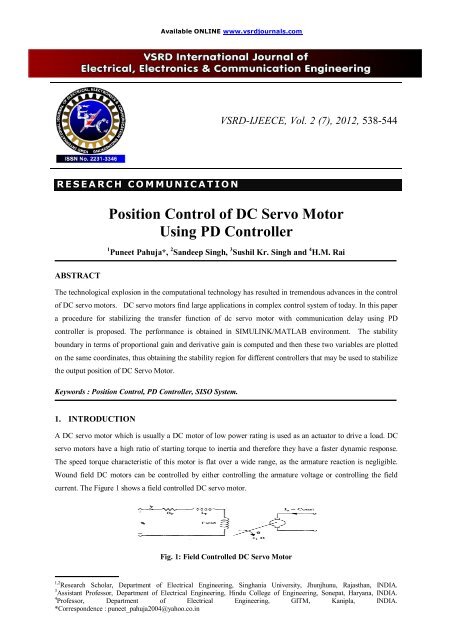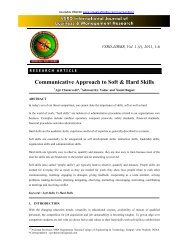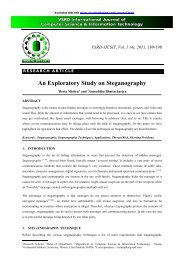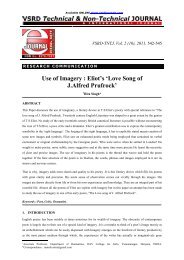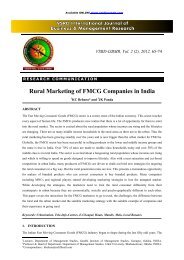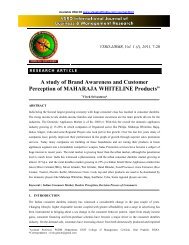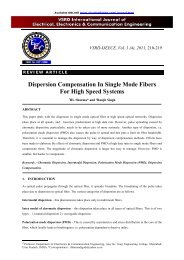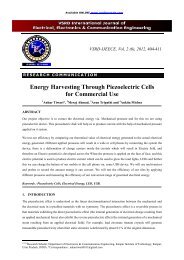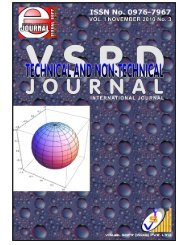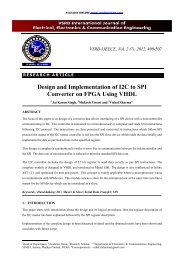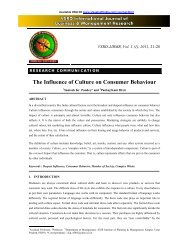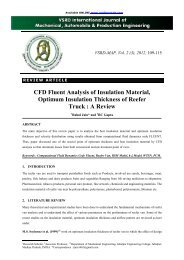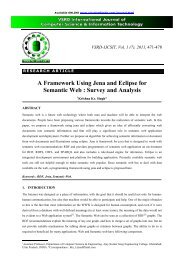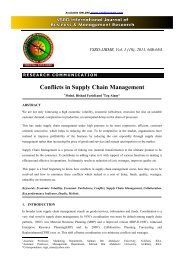Position Control of DC Servo Motor Using PD Controller - vsrd ...
Position Control of DC Servo Motor Using PD Controller - vsrd ...
Position Control of DC Servo Motor Using PD Controller - vsrd ...
You also want an ePaper? Increase the reach of your titles
YUMPU automatically turns print PDFs into web optimized ePapers that Google loves.
Available ONLINE www.<strong>vsrd</strong>journals.com<br />
VSRD-IJEECE, Vol. 2 (7), 2012, 538-544<br />
R E S E A R C H C O M M U N II C A T II O N<br />
<strong>Position</strong> <strong>Control</strong> <strong>of</strong> <strong>DC</strong> <strong>Servo</strong> <strong>Motor</strong><br />
<strong>Using</strong> <strong>PD</strong> <strong>Control</strong>ler<br />
1 Puneet Pahuja*, 2 Sandeep Singh, 3 Sushil Kr. Singh and 4 H.M. Rai<br />
ABSTRACT<br />
The technological explosion in the computational technology has resulted in tremendous advances in the control<br />
<strong>of</strong> <strong>DC</strong> servo motors. <strong>DC</strong> servo motors find large applications in complex control system <strong>of</strong> today. In this paper<br />
a procedure for stabilizing the transfer function <strong>of</strong> dc servo motor with communication delay using <strong>PD</strong><br />
controller is proposed. The performance is obtained in SIMULINK/MATLAB environment. The stability<br />
boundary in terms <strong>of</strong> proportional gain and derivative gain is computed and then these two variables are plotted<br />
on the same coordinates, thus obtaining the stability region for different controllers that may be used to stabilize<br />
the output position <strong>of</strong> <strong>DC</strong> <strong>Servo</strong> <strong>Motor</strong>.<br />
Keywords : <strong>Position</strong> <strong>Control</strong>, <strong>PD</strong> <strong>Control</strong>ler, SISO System.<br />
1. INTRODUCTION<br />
A <strong>DC</strong> servo motor which is usually a <strong>DC</strong> motor <strong>of</strong> low power rating is used as an actuator to drive a load. <strong>DC</strong><br />
servo motors have a high ratio <strong>of</strong> starting torque to inertia and therefore they have a faster dynamic response.<br />
The speed torque characteristic <strong>of</strong> this motor is flat over a wide range, as the armature reaction is negligible.<br />
Wound field <strong>DC</strong> motors can be controlled by either controlling the armature voltage or controlling the field<br />
current. The Figure 1 shows a field controlled <strong>DC</strong> servo motor.<br />
Fig. 1: Field <strong>Control</strong>led <strong>DC</strong> <strong>Servo</strong> <strong>Motor</strong><br />
____________________________<br />
1,2 Research Scholar, Department <strong>of</strong> Electrical Engineering, Singhania University, Jhunjhunu, Rajasthan, INDIA.<br />
3 Assistant Pr<strong>of</strong>essor, Department <strong>of</strong> Electrical Engineering, Hindu College <strong>of</strong> Engineering, Sonepat, Haryana, INDIA.<br />
4 Pr<strong>of</strong>essor, Department <strong>of</strong> Electrical Engineering, GITM, Kanipla, INDIA.<br />
*Correspondence : puneet_pahuja2004@yahoo.co.in
Puneet Pahuja et al / VSRD International Journal <strong>of</strong> Electrical, Electronics & Comm. Engg. Vol. 2 (7), 2012<br />
Where<br />
e<br />
f<br />
-applied field voltage(input),<br />
i<br />
f<br />
-field current,<br />
R -field resistance, L -field inductance,<br />
f<br />
f<br />
Ia<br />
-<br />
armature current which is held constant, - position <strong>of</strong> shaft (taken as output).<br />
To design feedback control for systems with time delay, it is necessary to consider the fact that the system’s<br />
future behaviors depend not only on the current value <strong>of</strong> the state variables, but also some past history <strong>of</strong> the<br />
state variables. The method proposed in this paper involves decomposing the plant frequency response into real<br />
and imaginary parts and computing the stabilizing parameters for each controller based on such decomposition.<br />
2. FINDING THE STABILITY BOUNDS FOR <strong>PD</strong> CONTROLLERS<br />
Consider the SISO system shown in Figure 2. The plant (<strong>DC</strong> <strong>Servo</strong> <strong>Motor</strong>) whose position is to be controlled is<br />
given by :<br />
G ( s) G( s)<br />
e <br />
p<br />
s<br />
… (1)<br />
Where is the communication (time) delay.<br />
+<br />
-<br />
<strong>Control</strong>ler<br />
G ( ) c<br />
s<br />
Plant (<strong>DC</strong><br />
servo motor)<br />
GP( s )<br />
The controller used is <strong>of</strong> <strong>PD</strong> type, so :<br />
Fig. 2: A SISO System with Unity Feedback<br />
G ( s)<br />
K K s<br />
c P d<br />
… (2)<br />
The problem is to find the values <strong>of</strong><br />
K<br />
P<br />
and<br />
Kd<br />
for which the closed-loop characteristic equation <strong>of</strong> the system<br />
( s) 1 G ( s) G ( s)<br />
is Hurwitz Stable. The characteristic equation in terms <strong>of</strong> j is :<br />
c<br />
P<br />
( j) 1 ( K jK )( R ( ) jI ( ))<br />
P d P P<br />
… (3)<br />
Expanding ( j)<br />
and setting it to zero produces :<br />
R ( ) I ( ) 0<br />
<br />
<br />
… (4)<br />
Where R ( ) 1 K<br />
PRP ( ) KdIP<br />
( )<br />
… (5)<br />
Page 539 <strong>of</strong> 544
Puneet Pahuja et al / VSRD International Journal <strong>of</strong> Electrical, Electronics & Comm. Engg. Vol. 2 (7), 2012<br />
And I( ) K<br />
PRP ( ) KdRP<br />
( )<br />
… (6)<br />
Setting the real and imaginary parts equal to zero gives :<br />
K ( R ( )) K ( I ( )) 1<br />
P P d P<br />
… (7)<br />
And K ( I ( )) K ( R<br />
( )) 0<br />
… (8)<br />
P P d P<br />
Hence, we need to solve the following system :<br />
RP<br />
( ) I<br />
P<br />
( ) KP<br />
1<br />
<br />
IP<br />
( ) RP<br />
( ) <br />
K<br />
<br />
d<br />
0<br />
<br />
<br />
… (9)<br />
Solving (9) for ω≠0, we obtain :<br />
K<br />
P<br />
( )<br />
<br />
R ( )<br />
P<br />
P<br />
G ( j)<br />
2<br />
… (10)<br />
IP<br />
( )<br />
Kd<br />
( )<br />
<br />
G ( j)<br />
P<br />
2<br />
… (11)<br />
Where<br />
P<br />
2 2 2<br />
P<br />
P<br />
G ( j) =(I ( )) +(R ( ))<br />
Solving (9) for ω=0, we find that K is arbitrary while :<br />
d<br />
K<br />
P<br />
1<br />
( )<br />
<br />
R (0)<br />
P<br />
… (12)<br />
And I<br />
P(0) 0<br />
… (13)<br />
The lower bound in (11) will be zero except for type –zero plants.<br />
Again, we need to find the upper bound<br />
c<br />
that is, the point where :<br />
K<br />
( ) K (0)<br />
P c P<br />
… (14)<br />
For a <strong>PD</strong> controller function when<br />
K (0) 0 , the amount <strong>of</strong> phase that this particular controller will add at<br />
P<br />
the critical frequency to the loop transfer function is anywhere from zero to 2<br />
radians which leaves a range <strong>of</strong><br />
Page 540 <strong>of</strong> 544
Puneet Pahuja et al / VSRD International Journal <strong>of</strong> Electrical, Electronics & Comm. Engg. Vol. 2 (7), 2012<br />
3<br />
,<br />
<br />
<br />
<br />
2 <br />
for the phase <strong>of</strong> the plant transfer function. Similarly, for a <strong>PD</strong> controller function when<br />
(0) 0<br />
<br />
K<br />
P<br />
, the amount <strong>of</strong> phase that this controller will add anywhere from to radians at the critical<br />
2<br />
frequency, which means that the phase <strong>of</strong> the plant transfer function at can be anywhere in the set<br />
3 <br />
, 2 <br />
2 <br />
.<br />
In the case where the plant transfer function is a type-one system or higher, K<br />
P(0) 0 will hold, resulting in<br />
the controller phase angle <strong>of</strong> 2<br />
radians at<br />
<br />
c<br />
and the plant transfer function phase <strong>of</strong><br />
c<br />
3<br />
2<br />
radians at the<br />
critical frequency. To design <strong>PD</strong> controllers that will satisfy specific gain and phase margins, a test function<br />
Ggp<br />
<br />
j<br />
Ae <br />
is inserted in the feed forward path as shown Figure 3. [1]<br />
…(15)<br />
Fig. 3 : A Basic <strong>Control</strong> System With A Test Function<br />
Then, G ( j) G( j) e Ae G( j)<br />
e<br />
P<br />
j j j <br />
… (16)<br />
Where G ( j) AG( j)<br />
… (17)<br />
And <br />
… (18)<br />
3. CASE STUDY<br />
The transfer function <strong>of</strong> the plant i.e. a typical <strong>DC</strong> servo motor taking shaft position as output and field voltage<br />
as input is[2];<br />
m( s) 1<br />
<br />
v<br />
f<br />
( s) s s<br />
1<br />
G(s) =<br />
… (19)<br />
For the communication delay <strong>of</strong> 1 :<br />
Page 541 <strong>of</strong> 544
Puneet Pahuja et al / VSRD International Journal <strong>of</strong> Electrical, Electronics & Comm. Engg. Vol. 2 (7), 2012<br />
s 1 1s<br />
Gp<br />
( s) G( s)<br />
e <br />
<br />
e<br />
s( s 1)<br />
… (20)<br />
We proceed with using equation (2) as the controller function. To obtain the values for<br />
K<br />
P<br />
and<br />
K<br />
d<br />
, we<br />
decompose equation (16) into real and imaginary parts and substitute them into equation (10) and (11) where<br />
<br />
<br />
0, c<br />
<br />
.<br />
Now we find the set <strong>of</strong> all stabilizing <strong>PD</strong> controllers for the <strong>DC</strong> <strong>Servo</strong> <strong>Motor</strong> such that the gain margin is greater<br />
than or equal to 2 and the phase margin is greater than or equal to 4<br />
. The frequency response is for the motor<br />
input voltage to the shaft angular position. The magnitude and phase plots <strong>of</strong> the motor are displayed in Figure<br />
4.<br />
40<br />
20<br />
Bode Diagram<br />
Magnitude (dB)<br />
0<br />
-20<br />
-40<br />
-60<br />
-80<br />
Phase (deg)<br />
-90<br />
-135<br />
-180<br />
-225<br />
-270<br />
-315<br />
-360<br />
System: <strong>DC</strong><strong>Servo</strong><strong>Motor</strong><br />
Frequency (rad/sec): 2.02<br />
Phase (deg): -270<br />
10 -2 10 -1 10 0 10 1<br />
Frequency (rad/sec)<br />
System: <strong>DC</strong><strong>Servo</strong><strong>Motor</strong><br />
Frequency (rad/sec): 0.863<br />
Phase (deg): -180<br />
Fig. 4 : Bode plot <strong>of</strong> <strong>DC</strong> <strong>Servo</strong> <strong>Motor</strong><br />
The general stability boundary locus is first computed, i.e., the locus when A=1 and θ=0. To design the<br />
controllers that satisfy the gain margin condition, set A=2 and θ=0 in equation (16). Then, from the given<br />
frequency response, extract the real and imaginary values at each ω and substitute it into equations (10) and<br />
(11) to obtain the stability boundary. To satisfy the criterion for the phase margin, repeat the procedure, but<br />
<br />
with A=1 and θ= . The results are shown in Figure 5.<br />
4<br />
Page 542 <strong>of</strong> 544
Puneet Pahuja et al / VSRD International Journal <strong>of</strong> Electrical, Electronics & Comm. Engg. Vol. 2 (7), 2012<br />
2<br />
1.8<br />
1.6<br />
GM = 1; PM = 0<br />
GM = 1, PM = /4<br />
GM = 2, PM = 0<br />
1.4<br />
1.2<br />
K p<br />
1<br />
0.8<br />
0.6<br />
0.4<br />
0.2<br />
0<br />
-1 -0.5 0 0.5 1 1.5 2 2.5<br />
K d<br />
Fig. 5 : Stability Region For Required Gain And Phase Margin<br />
To verify the results use the closed loop simulation <strong>of</strong> Figure 6. We chose<br />
K<br />
P<br />
=0.4 and<br />
K<br />
d<br />
=0.5 and tested the<br />
0<br />
response <strong>of</strong> the motor to a step input <strong>of</strong> 45 . From Figure 7 we find that the closed-loop system is indeed stable.<br />
Fig. 6 : Simulation Diagram To Verify The Results<br />
50<br />
45<br />
40<br />
Angular <strong>Position</strong>(degrees)<br />
35<br />
30<br />
25<br />
20<br />
15<br />
10<br />
5<br />
0<br />
0 5 10 15 20 25 30<br />
Time(Seconds)<br />
Fig. 7 : Step Response <strong>of</strong> the <strong>DC</strong> <strong>Servo</strong> <strong>Motor</strong> with desired values <strong>of</strong> Gain and Phase Margin<br />
Page 543 <strong>of</strong> 544
Puneet Pahuja et al / VSRD International Journal <strong>of</strong> Electrical, Electronics & Comm. Engg. Vol. 2 (7), 2012<br />
4. CONCLUSION<br />
After a number <strong>of</strong> repeated simulations in Matlab it is found that the given values <strong>of</strong> ( K , K ) stabilize the<br />
transfer function <strong>of</strong> the given <strong>DC</strong> servo motor. The case study is done. The results are useful to make the<br />
controller design for the <strong>Position</strong> control <strong>of</strong> <strong>DC</strong> <strong>Servo</strong> <strong>Motor</strong>.<br />
p<br />
d<br />
5. FUTURE SCOPE<br />
The same procedure can be used to find gains for PID controller, for controller design <strong>of</strong> Positon control <strong>of</strong> <strong>DC</strong><br />
<strong>Servo</strong> <strong>Motor</strong>. The work can be extended to design the robust PID controllers.<br />
6. REFERENCES<br />
[1] Tan., N. (2005): Computation <strong>of</strong> stabilizing PI and PID controllers for the processes with time delay, ISA<br />
Transactions, vol. 44.<br />
[2] Houpis, C. H. and Rasmussen, Steven J (1999): Quantitive Feedback Theory Fundamentals and<br />
Applications, Marcel Dekker Inc. New york Bassel.<br />
[3] Rai,, H.M. (2003):<strong>Control</strong> System Engineering, Satya Prakashan .<br />
[4] Silva, Guillermo J., Datta, Aniruddha, and Bhattacharya, S.P. (2005): PID controllers for Time-Delay<br />
Systems, Birkhauser.<br />
[5] Sujoldzic,S. and Watkins, J.M.(2005): Stabilization <strong>of</strong> an arbitrary order transfer function with time delsy<br />
using PID controllers, Proc. Of IEEE conf. on Decision and <strong>Control</strong>.<br />
<br />
Page 544 <strong>of</strong> 544


